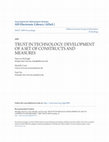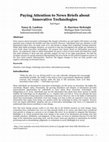Papers by D. Harrison McKnight

Online privacy management research related to e-commerce mainly focuses on whether or not to disc... more Online privacy management research related to e-commerce mainly focuses on whether or not to disclose information. Online social networking (OSN) on the other hand, offers a broader set of privacy management strategies. However, how individuals use these OSN strategies has not yet been studied. We survey college students about a popular OSN website and four privacy management strategies: privacy setting use, limiting content disclosure, friend list variety ,and firend list size. We take an exploratory approach using cluster analysis that results in four clusters with varying combinations of privacy management strategies. The findings reveal intriguing differences among the combinations of privacy control strategies. Overall, the findings support the control portfolios approach of Kirsch. Further, we show that each cluster has unique motivations for continued OSN use. Implications for future research are discussed.

Data base, Aug 10, 2021
This study seeks to broaden our understanding of the popular, yet under-researched, concept of mi... more This study seeks to broaden our understanding of the popular, yet under-researched, concept of micromanagement in the IT workforce by exploring IT professionals' trust in the competence of their supervisor as an antecedent to their perceptions of being micromanaged. The study also explores whether felt responsibility is the mechanism via which micromanagement negatively affects IT professionals' job satisfaction and organizational commitment, both proximal factors of turnover. These relationships are explored under the aegis of the Management Control Systems models, leader-member exchange theory, and the job characteristics model. Results indicate that trust in supervisor competence is a significant antecedent to IT professionals' perceptions of being micromanaged and that felt responsibility fully mediates the relationship between micromanagement and organizational commitment. The findings underscore the importance of building IT professionals' trust in their supervisor's competence and suggest that organizations proactively provide early intervention to negate the potential adverse impact on organizational outcomes.
IGI Global eBooks, Jan 18, 2011
Journal of Organizational and End User Computing, 2000

Journal of Management Information Systems, 2020
We examine why trust change occurs when potential users first encounter news about a specific tec... more We examine why trust change occurs when potential users first encounter news about a specific technology. We propose personal perceptions and three cognitive outcomes-attention, sensemaking, and threshold-affect trust change in educated young adults surveyed regarding a technology product. We find the outcomes of attention, sensemaking, and threshold positively affect trust change, while most hypothesized personal perceptions of the technology (e.g., reputation) do not predict trust change. For research, this implies scholars should focus more on cognitive outcomes of mental news brief processing than on technology perceptions. Our results also imply that research should examine other key dependent variables the way we studied trust change (e.g., "intention-to-use change"-to produce a more dynamic picture of how people adopt a technology). For practice, our data imply that tech companies can counter initial bad news about a technology by quickly providing strong positive news items to repair trust in that technology.
What does the word ‘trust’ mean? Scholars continue to express concern regarding their collective ... more What does the word ‘trust’ mean? Scholars continue to express concern regarding their collective lack of consensus about trust’s meaning. Conceptual confusion on trust makes comparing one trust study to another problematic. To facilitate cumulative trust research, the authors propose two kinds of trust typologies: (a) a classification system for types of trust, and (b) definitions of six related trust types that form a model. Some of the model’s implications for management are also outlined.

Journal of the Association for Information Systems, 2015
Information systems (IS) research has demonstrated that humans can and do trust technology. The c... more Information systems (IS) research has demonstrated that humans can and do trust technology. The current trust in technology literature employs two different types of trust in technology constructs. Some researchers use human-like trust constructs (e.g., benevolence, integrity, and ability), while other researchers use system-like trust constructs (e.g., helpfulness, reliability, and functionality). Interestingly, past research shows that both sets of measures influence important dependent variables, but the literature does not explain when one type should be used instead of the other type. In this paper, we use trust, social presence, and affordance theories to shed light on this research problem. We report on two studies. In study 1, we argue first that technologies vary in their perceived "humanness". Second, we argue that, because users perceive two technologies to differ in humanness, they will develop trust in each technology differently (i.e., along more human-like criteria or more system-like criteria). We study two technologies that vary in humanness to explore these differences theoretically and empirically. We demonstrate that, when the trust construct used aligns well with how human the technology is, it produces stronger effects on selected outcome variables than does a misaligned trust construct. In study 2, we assess whether these technologies differ in humanness based on social presence, social affordances, and affordances for sociality. We find that these factors do distinguish whether technology is more human-like or system-like. We provide implications for trust-in-technology research.
IFIP Advances in Information and Communication Technology, 2012
The use of general descriptive names, registered names, trademarks, etc. in this publication does... more The use of general descriptive names, registered names, trademarks, etc. in this publication does not imply, even in the absence of a specific statement, that such names are exempt from the relevant protective laws and regulations and therefore free for general use.

Information Systems Research, 2016
Trust in technology is an emerging research domain that examines trust in the technology artifact... more Trust in technology is an emerging research domain that examines trust in the technology artifact instead of trust in people. Although previous research finds that trust in technology can predict important outcomes, little research has examined the effect of unmet trust in technology expectations on trusting intentions. Furthermore, both trust and expectation disconfirmation theories suggest that trust disconfirmation effects may be more complex than the linear expectation disconfirmation model depicts. However, this complexity may only exist under certain contextual conditions. The current study contributes to this literature by introducing a nonlinear expectation disconfirmation theory model that extends understanding of trust-in-technology expectations and disconfirmation. Not only does the model include both technology trust expectations and technology trusting intention, it also introduces the concept of expectation maturity as a contextual factor. We collected data from three ...

Trust plays an important role in many Information Systems (IS)-enabled situations. Most IS resear... more Trust plays an important role in many Information Systems (IS)-enabled situations. Most IS research employs trust as a measure of interpersonal or interfirm relations, such as trust in a Web vendor or a virtual team member. Although trust in other people is important, this paper suggests that trust in the information technology (IT) itself may also play a role in shaping IT-related beliefs and behavior. To advance trust and technology research, this paper presents a set of trust in technology construct definitions and measures. These construct measures will be examined using tests of convergent, discriminant, and nomological validity. This study will contribute to the literature by offering a) a framework for distinguishing between trust in people and trust in technology, b) offering a theory based set of definitions necessary for investigating different forms of trust, and c) developing measures useful to research and practice for evaluating trust in technology.
When done well, grounded theory is an excellent qualitative research tool for explaining new or c... more When done well, grounded theory is an excellent qualitative research tool for explaining new or complex phenomena. Still, grounded theory is interpretative in nature, raising questions about the levels of reliability and validity in grounded theory studies. This paper argues that since grounded theory analysis methods are analogous to conceptual data modeling methods, data modeling techniques may be employed to enhance the validity and reliability of grounded theory research.

European Journal of Information Systems, 2023
While many factors drive the sharing economy’s growth, trust and motivations play critical roles.... more While many factors drive the sharing economy’s growth, trust and motivations play critical roles. However, which factors are more important to young consumers? This research compares a trust model with a motivation model—for predicting intention to use three platforms—Airbnb, Uber, and TaskRabbit. The trust and motivation models are compared within each platform, not between them. The study uses a survey sample of Midwest United States business undergraduates (nearly all Generation Z). Each sample varies in experience levels: relatively high experience Uber respondents, very low experience TaskRabbit respondents, and medium experience for Airbnb. Results show that within Uber, the trust model predicts significantly better than the motivation model. Within Airbnb and TaskRabbit, the motivation model predicts slightly (but not significantly) better. By combining the trust and motivation variables into one model by platform, we also find differing degrees of complementarity between the trust and motivation variables, with those for Airbnb being the most complementary in terms of predictive power and those for Uber being the least complementary. Within Airbnb and TaskRabbit, combining the trust and motivation models shows the two most significant variables were enjoyment and trusting intention. Within Uber, trusting intention and trusting beliefs in the provider were the most significant. We provide implications and directions for future research.

News sources about innovative technologies like Google’s driverless car and Apple’s Siri feature ... more News sources about innovative technologies like Google’s driverless car and Apple’s Siri feature can help potential users evaluate the benefits and risks involved. However, individuals must pay attention to this information before they can make sense of it, and decide to change their technology trusting intention. While other fields investigate attention, no research to date has investigated why people pay attention to news briefs about innovative technologies. We propose four factors based on information processing theory. An exploratory study in which respondents are given a series of news briefs and asked how much they paid attention to them and why, provides support for four of our eight propositions. We find the strongest reasons for paying attention/(disregarding) the news briefs are the positive/(negative) nature of the news brief content characteristics. However, the biggest changes in trust are from positive and negative technology involvement factors.

Journal of the Association of Information Systems, 2012
Expectation disconfirmation theory (EDT) posits that expectations, disconfirmation, and performan... more Expectation disconfirmation theory (EDT) posits that expectations, disconfirmation, and performance influence customer satisfaction. While information systems researchers have adopted EDT to explain user information technology (IT) satisfaction, they often use various EDT model subsets. Leaving out one or more key variables, or key relationships among the variables, can reduce EDT’s explanatory potential. It can also suggest an intervention for practice that is very different from (and inferior to) the intervention suggested by a more complete model. Performance is an especially beneficial but largely neglected EDT construct in IT research. Using EDT theory from the marketing literature, this paper explains and demonstrates the incremental value of using the complete IT EDT model with performance versus the simplified model without it. Studying software users, we find that the complete model with performance both reveals assimilation effects for less experienced users and uncovers a...

ACM Transactions on Management Information Systems, 2011
Trust plays an important role in many Information Systems (IS)-enabled situations. Most IS resear... more Trust plays an important role in many Information Systems (IS)-enabled situations. Most IS research employs trust as a measure of interpersonal or person-to-firm relations, such as trust in a Web vendor or a virtual team member. Although trust in other people is important, this article suggests that trust in the Information Technology (IT) itself also plays a role in shaping IT-related beliefs and behavior. To advance trust and technology research, this article presents a set of trust in technology construct definitions and measures. We also empirically examine these construct measures using tests of convergent, discriminant, and nomological validity. This study contributes to the literature by providing: (a) a framework that differentiates trust in technology from trust in people, (b) a theory-based set of definitions necessary for investigating different kinds of trust in technology, and (c) validated trust in technology measures useful to research and practice.

Proceedings of the Americas Conference on Information Systems , 2008
Several researchers have studied technology trust in terms of the technological artifact of the t... more Several researchers have studied technology trust in terms of the technological artifact of the technology. Two different types of trusting beliefs could apply to websites. First, the trusting beliefs may relate to interpersonal characteristics such as benevolence, competence, and integrity. Second, they may relate to technology characteristics such as helpfulness, functionality, and reliability. Since social networking websites like Facebook may demonstrate either interpersonal trust characteristics or technology trust characteristics, researchers may need to carefully choose the beliefs to model. Thus it is important to not only understand the conceptual meaning of these beliefs, but also whether human and technology trust beliefs of technology trust are distinct. Using data collected from Facebook users, we test alternate factor structures for a measurement model containing three interpersonal trust beliefs and three technology trust beliefs. We find the data fits a firstorder six-factor model the best. This suggests people can distinguish between trust in Facebook's interpersonal and technology trust characteristics. it also shows they can distinguish between the individual components of these characteristics.











Uploads
Papers by D. Harrison McKnight
intentions and that performance actually has a larger total effect on trusting intentions than satisfaction. The hypothesized model explains 39% of the variance in technology trusting intentions and 41% of the variance in usage continuance intentions.